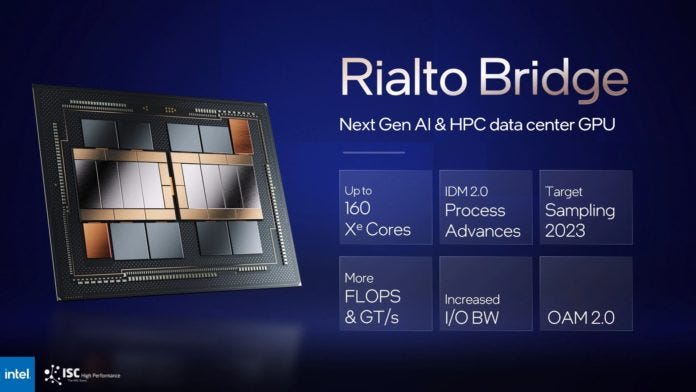Intel's Ambitious Leap: The Future of GPUs and XPUs
Written on
Chapter 1: Unveiling the Rialto Bridge
Intel's latest GPU, the Rialto Bridge, boasts an impressive 20,480 FP32 units and a power consumption of 800W. Although the first generation hasn't hit the market yet, Intel has already revealed plans for its successor, an advanced GPU architecture featuring numerous chiplets. The long-term vision is to merge both GPU and CPU functionalities into a single entity referred to as the "XPU."
In recent discussions, we highlighted the new supercomputer, Frontier, which is the first to achieve exascale performance. While Frontier utilizes AMD's processors and GPUs, Intel initially intended to contribute to the U.S. exascale supercomputer landscape with its Ponte Vecchio GPU. Despite delays, Intel has now introduced the Rialto Bridge, which, while promising, appears to provide only marginal improvements over its predecessor.

Source: Intel
The Rialto Bridge, formerly known as "Ponte Vecchio Next," represents an evolution of the Ponte Vecchio concept, aimed at creating a product that consolidates high-performance computing (HPC) capabilities into a single XPU. Intel's upcoming Falcon Shores generation will ultimately fulfill this goal, although it remains in the development phase. Meanwhile, the Rialto Bridge is expected to be launched in 2023, although it may initially be available only as a sample.
Section 1.1: Architecture Insights
Visually, the Rialto Bridge bears a resemblance to Ponte Vecchio, characterized by its expansive design housing numerous chiplets, or "tiles," that combine to form the GPU. This architecture is designed exclusively for server use, indicating it may never be available as a traditional PCI Express graphics card.
The compute units are organized into eight chiplets, with additional components providing interconnectivity. While the separate "Rambo Cache" chiplets appear to have been integrated into the compute chiplets, the overall design suggests a more streamlined approach with larger compute units compared to the fragmented layout of its predecessor.
Subsection 1.1.1: Performance Enhancements
Intel has not disclosed extensive details about the Rialto Bridge, but it appears to retain a similar architectural framework to Ponte Vecchio, known as Xe HPC. Notably, the number of Xe Core units is expected to rise from 128 to 160, while AI-driven Matrix Core units will increase from 1024 to 1280. This could lead to performance gains of approximately 30% across various applications.
For context, Intel's Arc gaming GPU features 32 Xe Cores, translating to 4096 shaders. If the assumption holds that each Xe Core comprises 128 shaders, then 160 Xe Cores could yield 20,480 shaders.
Section 1.2: Increased Power and Future Prospects
Intel has hinted that the Rialto Bridge will leverage new manufacturing processes, possibly moving towards a 4nm architecture. However, power consumption is projected to rise, with the TDP increasing from 600W in the previous generation to 800W in the Rialto Bridge. This shift aligns with broader trends in the computing industry, where both CPU and GPU power demands are escalating.
Despite this increase, the anticipated performance-to-power ratio may not reflect significant advancements, suggesting that Intel is still working within the confines of the original architecture.
Chapter 2: The Path to Falcon Shores
Intel has also teased its next-generation hardware, Falcon Shores, which is slated for release in 2024. This new architecture aims to unify the capabilities of a powerful GPU, akin to Ponte Vecchio and Rialto Bridge, with a Xeon processor into a singular XPU. This strategy is poised to dramatically enhance memory capacity, throughput, and energy efficiency.
In the first video titled "I Tested Every Game I Own on an Intel Arc GPU," the presenter explores the performance of Intel's Arc GPU across various gaming scenarios, shedding light on its capabilities and potential shortcomings.
The second video, "Intel Saved Their Most Expensive Mistake...," discusses Intel's strategic shifts and how it navigates its challenges in the competitive GPU market.
Intel's move toward integrating CPU and GPU functionalities into XPUs demonstrates a forward-thinking approach aimed at maintaining competitiveness against Nvidia and AMD. However, the impending Falcon Shores generation may alter the landscape of high-performance computing, potentially rendering standalone GPUs obsolete for supercomputing applications.
As Intel navigates these technological advancements, it will be fascinating to observe how it capitalizes on its stronghold in processors to forge a successful path in the GPU domain. While the timeline for these developments may extend into 2025, the competitive landscape will likely continue to evolve.
Your thoughts on this topic are welcome! Please share your insights in the comments, and feel free to explore my other writings. If you enjoy this content, a clap or a follow would be appreciated to stay updated on future posts.